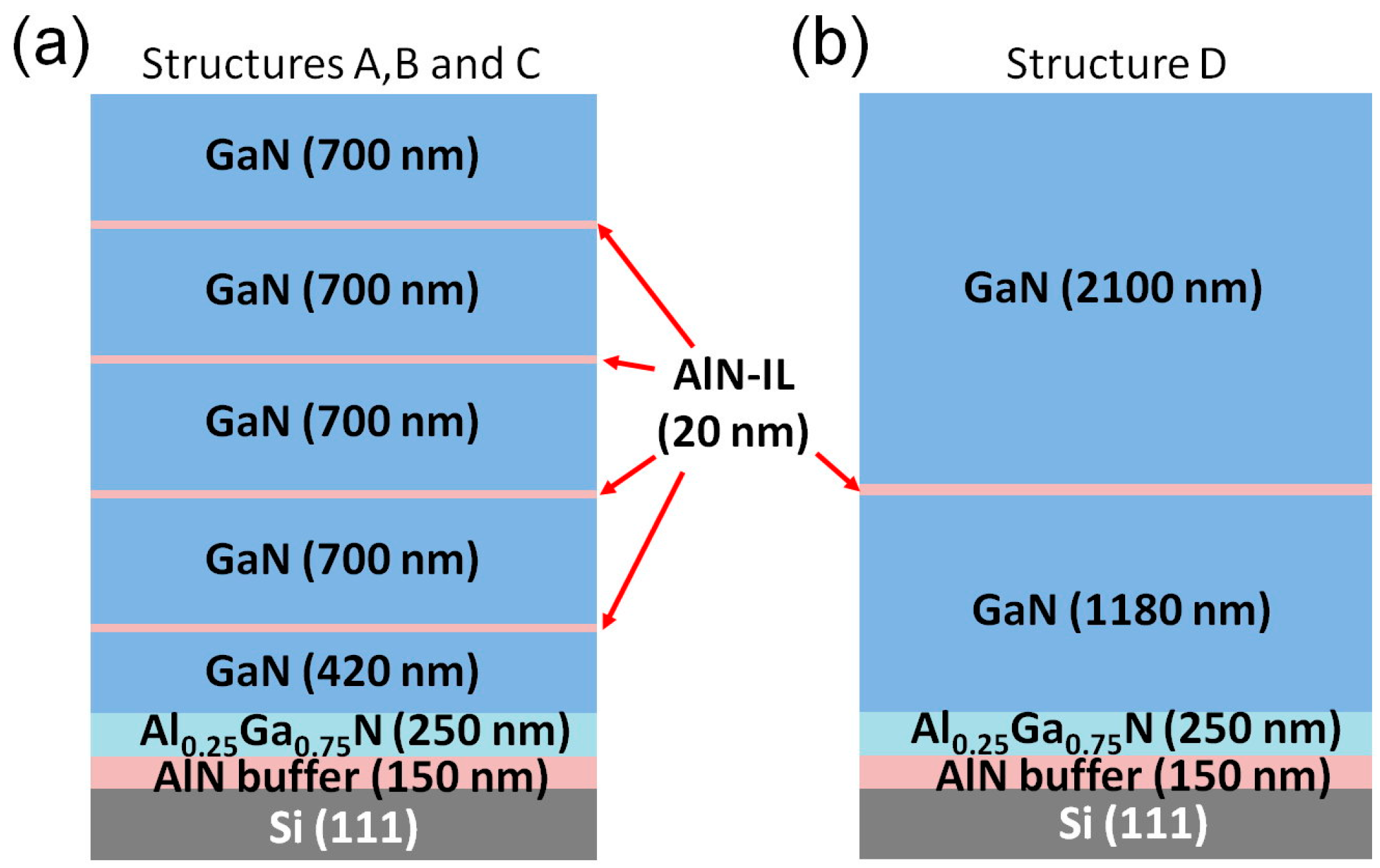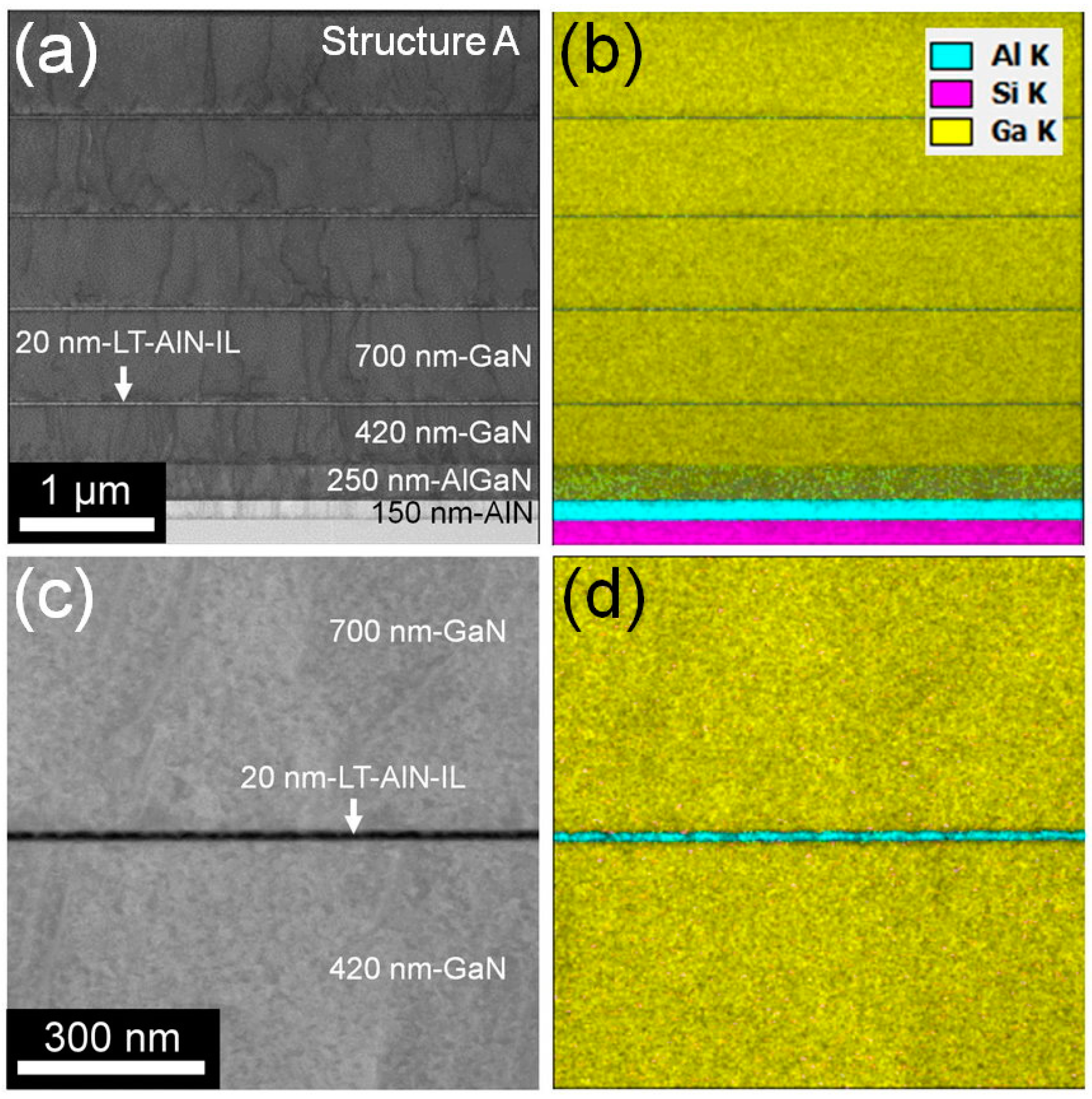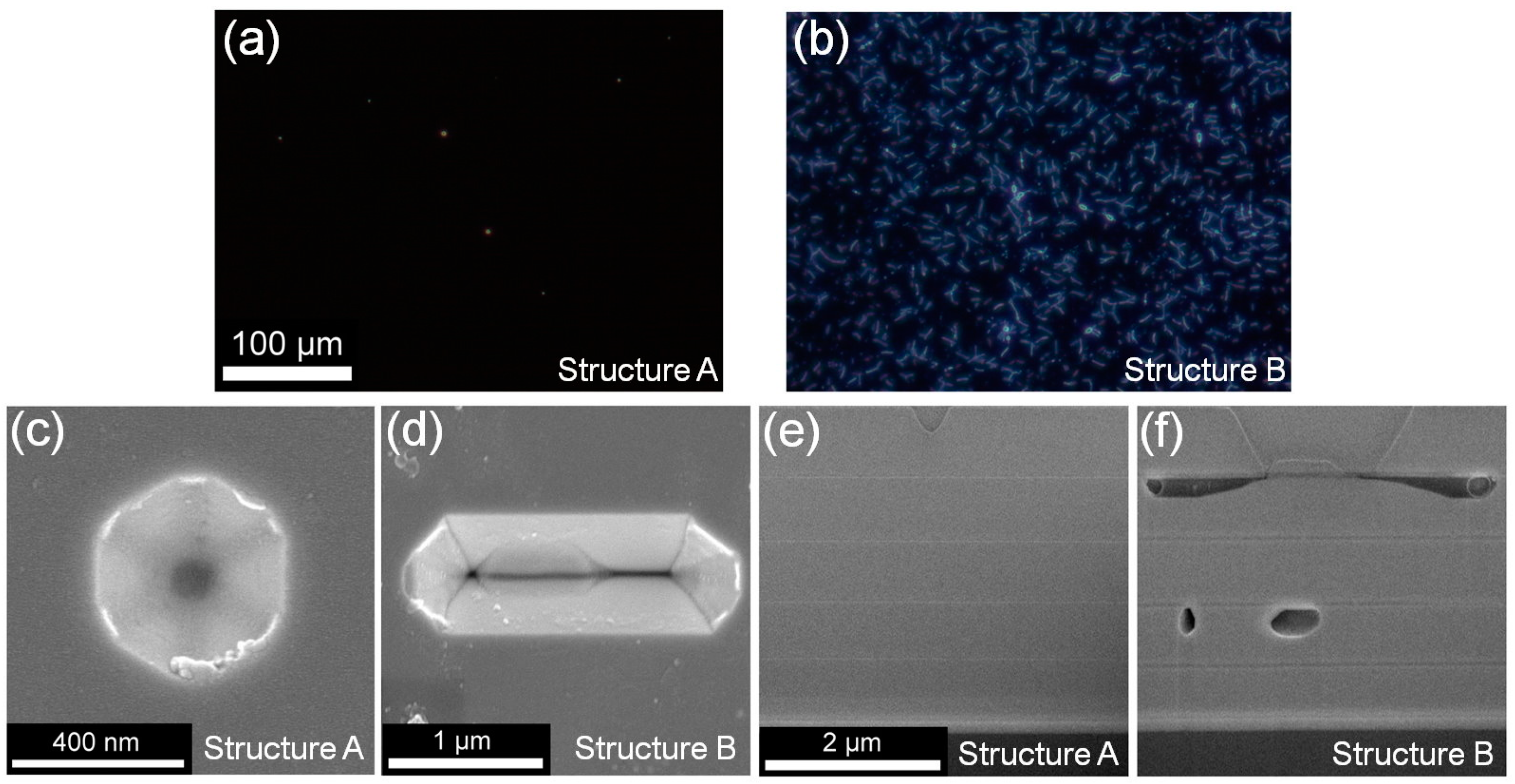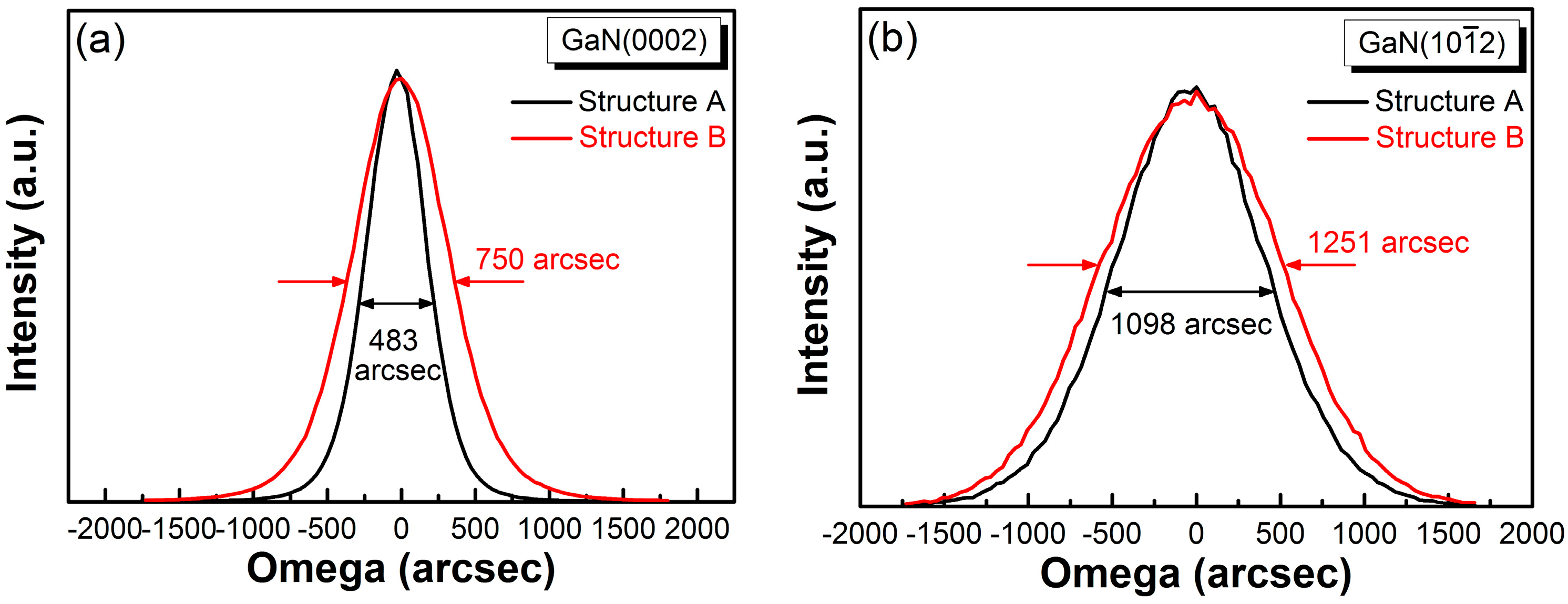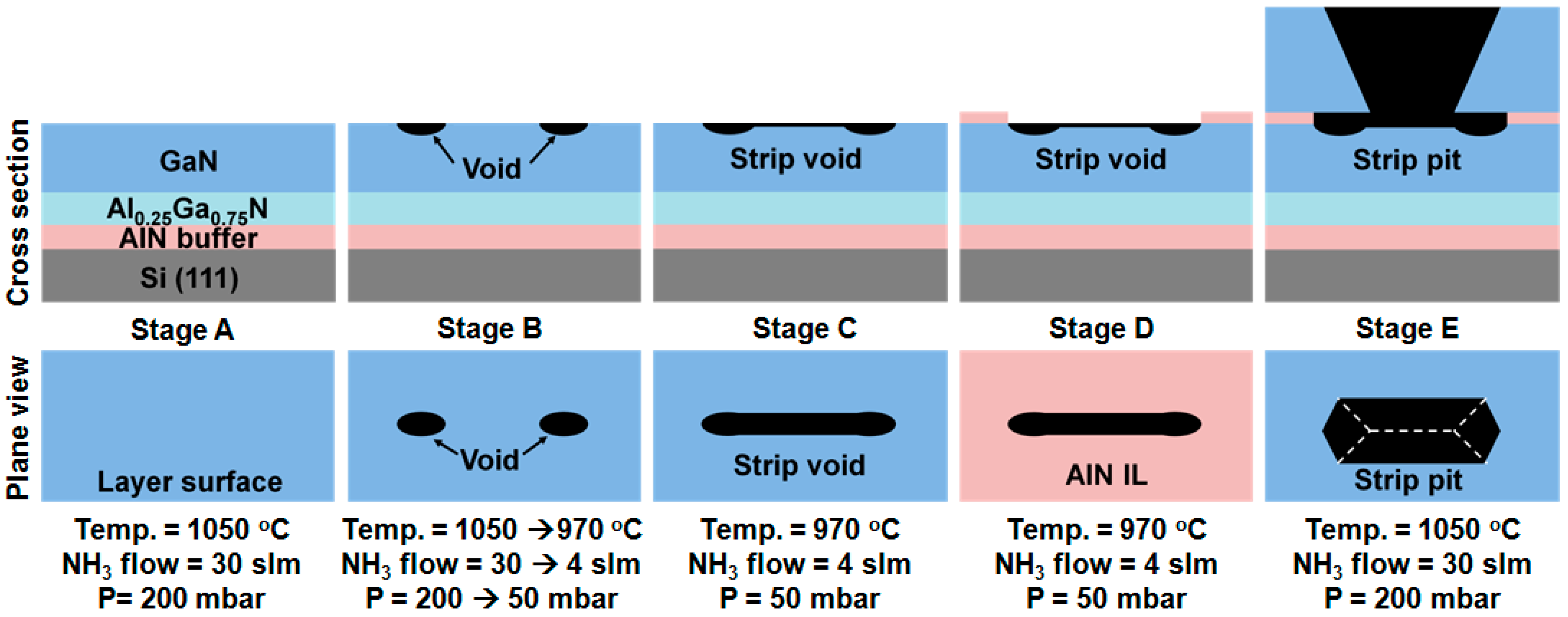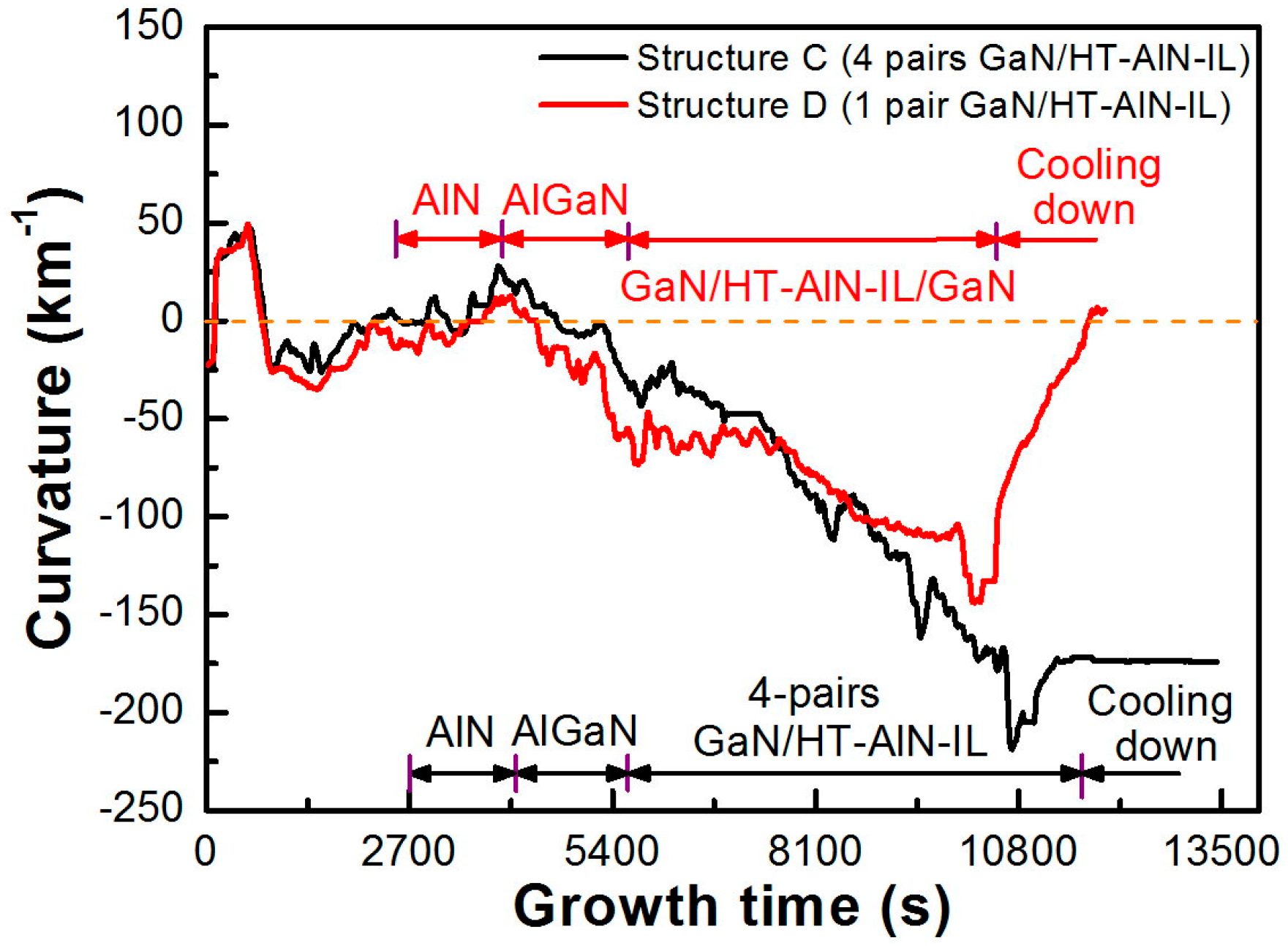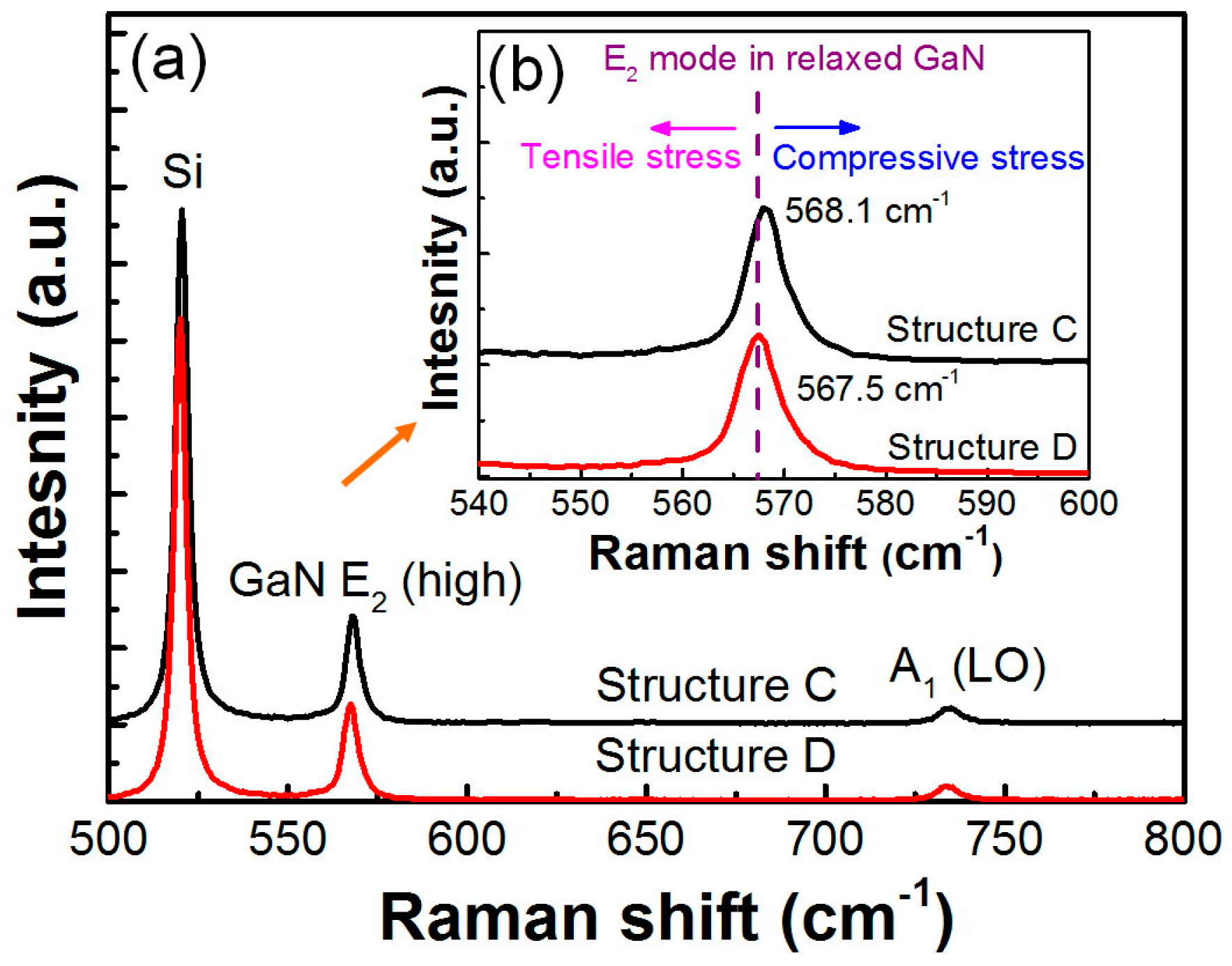2.2. Epilayer Characteristics
Figure 2a depicts the bright-field scanning transmission electron microscopy (BF-STEM) cross-sectional image of structure A containing LT AlN ILs. The Si substrate, 150-nm AlN buffer layer, 250-nm AlGaN transition layer, 420-nm GaN epilayer, 20-nm LT AlN ILs, and 700-nm GaN epilayers are discernible in the figure. Dislocations of 420 nm-GaN generated by the lattice mismatch (19%) between AlN (a
0 = 3.11 Å) and Si (111) (a
0 = 5.43 Å) were suppressed after first 700-nm GaN grown on LT AlN IL by inducing the compressive stress [
14,
15]. As shown in
Figure 2a, the dislocation density of 420 nm-GaN, first 700 nm-GaN, second 700 nm-GaN, third 700 nm-GaN, and fourth 700 nm-GaN were 1.3 × 10
9, 6.2 × 10
8, 6.2 × 10
8, 5.5 × 10
8, and 5.5 × 10
8 cm
−2, respectively. This result indicates that the dislocation density of first 700 nm-GaN grown on LT AlN IL was suppressed than the density of 420 nm-GaN underlayer. After the first 700 nm-GaN, the GaN layers reveal a similar dislocation density. In
Figure 2b, the distribution of the Si, Al, and Ga elements measured by energy-dispersive X-ray (EDX) are represented by various colors for sequentially distinguishing among the Si substrate, the AlN buffer layer, the AlGaN transition layer, the GaN epilayers, and the LT AlN ILs. As shown in
Figure 2c,d, high angle-annular dark field (HAADF) and EDX measurements indicated that the interfaces between the LT AlN IL and the GaN epilayer are abrupt and that the Al element is limited completely in the LT AlN IL. The dark area in the grayscale image of
Figure 2c represents a low atomic number for Al, whereas the bright area represents a high atomic number for Ga [
16]; the thickness of the LT AlN ILs was 20-nm.
In situ curvature and temperature monitors were employed to characterize the stress and the temperatures of the structures during growth, and the results are illustrated in
Figure 3. The AlN ILs of structures A and B were grown under 4 slm of NH
3.
Figure 3a shows the result of structure A with the LT AlN ILs grown at 680 °C. During the growth of the GaN epilayers, the curvature dropped gradually to −200 km
−1 when the LT AlN ILs were inserted. Due to the 55% mismatch of TECs between GaN and Si, the curvature should typically change from a negative (compression) to a positive (tension) value during wafer cooling process. However, the curvature maintained at −200 km
−1 indicates that the Si substrate was subject to a plastic deformation during the growth of the GaN epilayers with the LT AlN ILs. This implies that the stress in the GaN epilayer was under a state of compression and that no cracks appeared on the surface. Whereas,
Figure 3b illustrates the result of structure B with the HT AlN ILs grown at 970 °C during the growth of the GaN epilayers, the curvature of structure B gradually dropped to −100 km
−1 when the HT AlN ILs were inserted. Then, during cooling process, the curvature changed considerably to 75 km
−1, indicating the generation of tension and cracks on the surface. This is a typical result of growing a GaN epilayer on a Si substrate. The results of the GaN epilayers containing the LT and HT AlN ILs, as shown in
Figure 3, indicated general variations of stress in the GaN epilayers.
Room-temperature Raman spectra were used to quantify the stress of the GaN epilayers through a Raman shift of an E
2 (high) peak. The A
1 (LO) and E
2 (high) modes of GaN are shown in
Figure 4a [
17,
18]. The frequency of the E
2 (high) phonon peak of unstressed GaN is 567.6 cm
−1, which is generally used to evaluate the strain in epilayers [
18]. The stress of the epilayers was calculated according to the Raman shift by solving for σ
xx = Δω/K, where Δω is the difference in the E
2 (high) phonon peaks between the stressed and unstressed GaN epilayers, and K (−4.3 cm
−1 GPa
−1) is the strain coefficient [
19,
20].
As shown in
Figure 4b, the positions of the E
2 (high) peak measured from structures A and B were 568.07 and 566.85 cm
−1, respectively. The E
2 (high) peak in structure A shifted to a high frequency compared with that of unstressed GaN, indicating that the GaN epilayer was under a compressive stress of −0.109 GPa. By contrast, the E
2 (high) peak in structure B shifted to a low frequency compared with that of unstressed GaN, indicating that the GaN epilayer was under a tensile stress of 0.174 GPa. After cooling, the GaN epilayers containing the LT and HT AlN ILs were both subject to a compressive stress and a tensile stress, respectively. The results shown in
Figure 3 and
Figure 4 are consistent with those reported by Dadgar et al., who demonstrated that the strain relaxation of GaN epilayers by inserting LT AlN ILs can further accumulate the compressive stress during the growth of GaN on Si [
9,
10]. Therefore, the relaxed LT AlN ILs can induce compressive stress to the subsequent GaN epilayer, whereas strained HT AlN ILs cannot induce sufficient compressive stress to the subsequent GaN epilayer. In our case, we demonstrate the effect of the GaN/AlN IL/GaN interfaces on the stresses of the GaN epitaxial structure grown on a Si substrate. Meanwhile, the continuous interface of AlN IL could induce compression in the GaN epilayer. As compared to the continuous interface, the discontinuous interface of AlN IL could reduce the compression in the GaN epilayer. To control the stress during growth, the growth temperature of AlN ILs is an effective factor for realizing a thick and crack-free GaN epilayer on a Si substrate.
Figure 5a,b depict the dark-field optical microscopy (OM) images used to characterize the surface of structures A and B. As shown in
Figure 5a, only a few epitaxial pits were present on the surface of structure A (LT AlN ILs). The pits could originate from the rough interface caused by the LT AlN ILs. Compared with the pits of structure A, two types of defects—namely strip defects (cracks or voids) and pits—were observed for structure B containing HT AlN ILs, as shown in
Figure 5b. To inspect all the defects shown in
Figure 5b, the focal length was adjusted to be below the surface of structure B. This is to confirm that certain defects in structure B were buried in the epilayer.
Figure 5c,d illustrate the surface of structures A and B, respectively, by focus-ion-beam scanning electron microscopy (FIB-SEM). The epitaxial pits have a hexagonal shape which is caused by screw dislocations propagating to the surface. However, the origin of the strip pits shown in
Figure 5d is more complicated. FIB-SEM was employed to inspect the generation of the pits under the surfaces by examining the cross-sectional images shown in
Figure 5e,f. The cross-sectional image depicting the area below the pit (
Figure 5c,e) indicates the presence of a pit and the interfaces between the GaN epilayers and LT AlN ILs are continuous. A continuous interface can induce compression during the growth of the subsequent GaN epilayer, and this compressive stress is proportional to the number of AlN ILs. This is the reason the Si substrate and the GaN epilayer in structure A underwent a plastic deformation and compression. However, in structure B, the cross-sectional image depicting the area below the strip pit (
Figure 5d,f) indicates that, in addition to the strip pits on the surface, voids are present between the interfaces of the 700-nm GaN epilayers and HT AlN ILs. Due to this, the interfaces are discontinuous. The generation of voids was caused by the apertures of cracked AlN ILs grown at temperatures higher than 900 °C [
11,
12] and insufficient NH
3 flow rate (4 slm), which give rise to Ga diffusion and GaN decomposition. In addition to the generation of voids caused by the cracked AlN ILs, etching of GaN is also another possible mechanism. During the transition of growth conditions from the 700-nm GaN epilayer to the HT AlN IL, the growth temperature was changed from 1050 to 970 °C and meantime the corresponding NH
3 flow rate was changed from 30 to 4 slm. In this process, the temperature was higher than 970 °C and the NH
3 flow could be insufficient to prevent the GaN from decomposition. The surface of the GaN epilayer was exposed to the ambience of decomposition, which caused the etched voids along the GaN <
> crystalline directions. From the bottom to the surface of the GaN epilayer grown on Si, voids were generated separately from the interface and extended into to a large strip pit, and finally, discontinuous interfaces and a large pit were observed for the GaN epilayer prepared on Si. The discontinuous interface induced less compressive stress to the subsequent GaN epilayer. In the cooling process, compressive stress accumulated during GaN growth is used to compensate the tensile stress caused by the TEC mismatch between GaN and Si. Therefore, structure B with discontinuous interfaces and less compressive stress, resulted in tensile stress after the wafer cooling process. Note that a sufficient NH
3 flow plays a critical role to prevent the decomposition of GaN at high temperature. To quantitatively study the crystalline quality, the GaN epilayers of structures A and B were examined by X-ray diffraction (XRD). The rocking curves of GaN (0002) and (
) for structures A and B are shown in
Figure 6. In contrast to structure A with the full width at half-maximum (FWHM) values of GaN (0002) for 483 arcsec and GaN (
) for 1098 arcsec, structure B with discontinuous interfaces and large pits has the higher FWHM values in GaN (0002) and (
) for 750 and 1251 arcsec, respectively. The FWHM of ω-scan and mosaic model can be described as [
21]
where
βω is the FWHM measured from different reflections;
and
are the contributions of screw and edge dislocations to the FWHM of ω-scan.
ρe and
ρs are the edge and screw dislocation densities;
Δωs and
Δωe are referred to as tilt and twist, which can be calculated by FWHM of (0002) and
, respectively.
and
are the Burgers vectors of edge-type and screw-type dislocations, respectively. We have estimated the dislocation density from the FWHM of GaN (0002) and (
). The densities of the screw and edge dislocations of structure A were 2.27 × 10
8 and 3.05 × 10
9 cm
−2, and structure B for 5.46 × 10
8 and 3.91 × 10
9 cm
−2, respectively. The results indicate that structure A grown with LT AlN ILs shows higher crystalline quality than structure B.
Other than the NH
3 flow rate, structures B and C were grown under the same growth conditions. The structures were used to examine the effect of changing NH
3 flow rate from 4 to 12.5 slm for stress control. The in situ curvature of structures B and C are illustrated in
Figure 7. During the growth of the GaN epilayers, the curvatures of structures B and C with HT AlN ILs prepared at NH
3 flow rates of 4 and 12.5 slm, dropped to −75 and −225 km
−1, respectively. After cooling, the Si substrate and the GaN epilayer in structure C underwent a plastic deformation and compression, indicating that the adjustment of the NH
3 flow rate from 4 to 12.5 slm leads to the stress changed from a state of tension to compression. The cross-sectional image shown in
Figure 7 indicates that most of the interfaces between the GaN epilayers and HT AlN ILs are continuous, confirming that adjusting the NH
3 flow rate can suppress GaN decomposition to realize a continuous interface and a stress-controllable GaN epilayer on Si with HT AlN ILs.
Figure 8 illustrates stages A–E, to represent the sequence of discontinuous interface and strip pit generation during HT-AlN IL growth under insufficient NH
3 flow. In stage A, a 420-nm GaN epilayer is grown on top of the epi structure, which consists of the AlN buffer layer and the AlGaN transition layer. During stage B, the NH
3 flow and temperature changes gradually from 30 to 4 slm and from 1050 °C to 970 °C, respectively; here, the temperature is higher than 970 °C and the NH
3 flow could be insufficient to prevent the GaN from decomposing. Furthermore, the surface of the GaN epilayer is exposed to the ambience of decomposition, which produces etched voids. Combined with the decreasing NH
3 flow, a strip void emerges along the GaN [110] crystalline directions in stage C. In stage D, the HT AlN IL is grown on the etched GaN epilayer, however, this growth is discontinuous because of the strip void generation. Finally, in stage E, a 700-nm GaN epilayer is grown on the HT AlN IL. However, the strip void caused by GaN decomposition is too large to be flattened laterally; thus, a strip pit is produced on the surface of the 700-nm GaN epilayer.
The voids generated between the interfaces of the 700-nm GaN epilayers and HT AlN ILs are explained by the results of structure B and C. During the transition of growth conditions from the 700-nm GaN epilayer to the HT AlN IL, providing sufficient NH
3 flow can suppress the decomposition of the 700-nm GaN epilayer to realize continuous interfaces and stress-controllable GaN epilayers. Because the compressive stress of structure C was high during the GaN epilayer growth, the Si substrate was subject to plastic deformation. Therefore, the curvature of structure C was maintained at −225 km
−1 after cooling. An ideal wafer curvature should approximate 0 km
−1 after cooling, which means that the bow in the wafer is flatter and more suitable for devices process. To improve the curvature of structure C (
Figure 7), the stress caused by the GaN epilayer should be controllable during growth by adjusting the number of continuous interfaces between the 700-nm GaN epilayer and HT AlN IL. Therefore, the adjusted structure D with one HT AlN IL is shown in
Figure 1b; the total thickness of the GaN epilayer remains 3.7 μm. The growth parameters for structure D are same as for structure C. Moreover, the GaN epilayers directly below and above the HT AlN are 1180 and 2100 nm, respectively. The growth parameters of structure D are the same as for structure C.
Figure 9 indicates that the curvature of structure D, which has one HT AlN IL, approximates 5 km
−1 after cooling. As shown in
Figure 10, the positions of the E
2 (high) peak for structures C and D were 568.1 and 567.5 cm
−1, respectively. The E
2 (high) peak of structure C shifted to higher frequency side than that of unstressed GaN, indicating a compressive stress of −0.116 GPa. For structure D, the E
2 (high) peak shifted to lower frequency side indicates a tensile stress of 0.023 GPa. Because there is one HT AlN IL and several continuous interfaces between the GaN epilayers and HT AlN IL, the generated compressive stress during the growth of the GaN epilayers was moderate and the Si substrate of structure D was not subjected to plastic deformation. The results in
Figure 9 and
Figure 10 show that adjusting the number of continuous interfaces affects the GaN epilayer stress, and the wafer bow of structure D is flatter than that of structure C after cooling.
